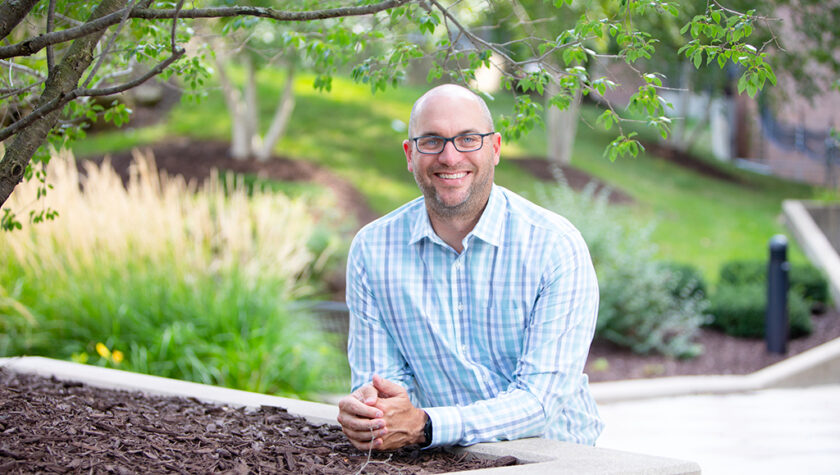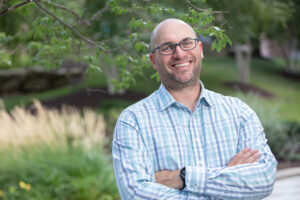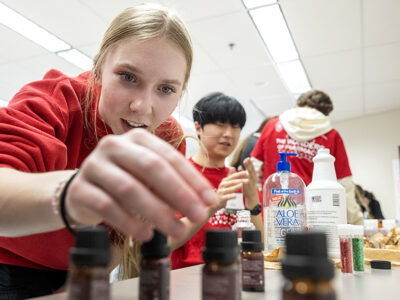
13
September

Alum Lucas Schulz improves antibiotic usage and prescribing at UW Health to tackle antimicrobial resistance
By Mary Magnuson
Have you ever been prescribed an antibiotic? Maybe it was vancomycin before a surgery or amoxicillin for an ear infection. Chances are, you have, as antibiotics have become one of the strongest weapons in healthcare’s fight against infectious diseases. In 2016, Americans received 270.2 million antibiotic prescriptions — enough to cover five out of six Americans.
But with antimicrobial-resistant infections on the rise — according to the Centers for Disease Control, over 2.8 million people in the U.S. every year contract a resistant infection — infectious disease specialists like Lucas Schulz (PharmD ‘08) are reworking the systems surrounding antibiotic prescriptions.
A graduate of the University of Wisconsin–Madison School of Pharmacy, Schulz, as clinical coordinator for infectious disease at UW Health, is developing new ways to steward antibiotics and ward off the development — or spread — of antimicrobial resistance while improving patient outcomes.
“I think an important part of pharmacy practice, that all too often goes unrecognized, is doing clinical research and publishing the work that shows improved antibiotic utilization.”
—Lucas Schulz
His work has resulted in more than 70 publications, including a recent article in JAMA Internal Medicine, detailing a study into how COVID-19 impacted other respiratory diseases and the antibiotics prescribed for such diseases that was featured on CNN. His stewardship programs have led to UW Health being recognized by The Joint Commission and Infectious Diseases Society of America as a Center of Excellence.
“I think an important part of pharmacy practice, that all too often goes unrecognized, is doing clinical research and publishing the work that shows improved antibiotic utilization,” Schulz says. “How do we get our best practices out into the world so that others can critically evaluate them and integrate into their local clinical practice? Publishing and presenting are great ways to share best practices and improve patient care.”
Changing the prescription process
Take vancomycin, for example. One of the most commonly administered antibiotics in hospitals, it’s been in use since the 1950s to prevent bacterial infections like MRSA after a surgery.
To preserve the efficacy of the drug considering the development of highly-resistant bacteria, like Staphylococcus aureus and Enterococci, the Infectious Disease Society of America recently recommended that pharmacists should use “area under the curve” dosing, which relies on blood samples to monitor how the drug is moving through the body, ensuring patients receive just the right dose. These calculations take up valuable time and effort, so Schulz decided to figure out a more time-effective way to steward vancomycin.

Instead of pharmacokinetic calculations for all patients, Schulz paired vancomycin use with early, rapid diagnostic testing. Determining if a patient carries MRSA on their skin and other locations quickly by sending a patient’s sample to the microbiology laboratory pharmacists can determine a patient’s infection risk and whether they need vancomycin.
“Discontinuing vancomycin, rather than checking unnecessary blood levels, is a good example of how important critical thinking helps,” Schulz says. “As an infectious disease pharmacist, you think really strategically about what’s best for the patient, then work with the laboratory to advance pharmacy practice so that pharmacists are able to order the appropriate tests and discontinue the antibiotic that’s not necessary.”
Often, Schulz’s work is directed at reducing the usage of antibiotics. But sometimes, his research instead focuses on optimizing prescriptions for specific conditions.
The COVID-19 pandemic strained hospitals and limited hospital bed availability. Hospital admission takes up bed space, increases health-care costs, and increases the patient’s risk and exposure to hospital-acquired infections. For example, patients were often admitted so they can receive intravenous antibiotics for the treatment of skin infections. The antibiotic oritavancin can be administered as a single dose and stay in the body for around 10 days, all the while treating the infection. Oritavancin carries a high price tag and was used infrequently, but Schulz and his team looked at the balance — if a drug can keep patients out of the hospital by maintaining a sufficiently high blood level, is it worth the monetary cost to make more bed space available for other sick patients without increasing the risk of resistance development? Following their assessment, UW Health now uses oritavancin on patients in the ER or after orthopedic surgery to prevent a longer hospital stay.
“I think systematically, remaining system-focused and making sure that we use antimicrobials appropriately across the enterprise,” Schulz says. “We set standards and practice expectations, which we then follow and continuously and adapt so that we can care for patients in the best way.”
Leading through a pandemic
When the COVID-19 pandemic hit the United States in early 2020, much of Schulz’s work quickly evolved into creating and modifying COVID-19 care protocols.
“This was the perfect storm for my critical care training and infectious diseases experience. We had critically ill patients suffering from an infectious disease,” Schulz says, whose expertise made him a valuable voice on the team.
Schulz led the creation of inpatient treatment guidelines for COVID-19 at UW Health, which meant bringing together an interdisciplinary team of pharmacists, physicians, microbiologists, and administrators to evaluate rapidly emerging data and create a customized strategy to treat the disease at UW Health and beyond. But, even with the pandemic disrupting health systems across the country, 60 to 70 percent of patients in the hospital were still non-COVID patients receiving antimicrobials, and Schulz’s team never lost focus on them.
“My job became collating, analyzing, creating, and continuously reconciling new data into a comprehensive COVID-19 guideline.”
—Lucas Schulz
“My job became collating, analyzing, creating, and continuously reconciling new data into a comprehensive COVID-19 guideline, while still maintaining our high practice standards on our inpatient and ambulatory antimicrobial stewardship programs, our infectious diseases clinic programs, and support of our infectious disease providers dyad partners,” Schulz says. “The ID program works together to care for patients with very complex infectious disease conditions that require specialty care, and those patients still needed to have their care optimized.”
Throughout the pandemic, Schulz and his colleagues monitored the pandemic’s effect on other respiratory illnesses.
“We were interested to see what mask-wearing, social distancing, and the closing of many businesses, schools, and restaurants did to the use of antibiotics for the treatment of respiratory conditions,” he says.
Using data from UW Health and the Wisconsin State Laboratory of Hygiene, they found that winter seasonal viruses dropped from an average of 4,800 per month during pre-pandemic season, to an average of just 12 per month.
Pandemic safety measures also affected respiratory infections, according to their study, which was published in JAMA Internal Medicine. During the pandemic, antibiotic prescriptions for respiratory tract infections fell 79 percent.
“We learned that if we have good, rapid diagnostic testing capabilities readily available in clinic, and we educate patients and physicians about the utility of those tests and the prevalence of a circulating virus, we can do a lot to stem inappropriate antibiotic prescribing,” Schulz says. “Antibiotics will not treat a viral infection. Inappropriate use only leads to adverse effects and the development of resistance.”

Schulz says the pandemic taught him a lot about the treatment and response to infectious diseases, even though he’s been in the specialty for over 10 years.
“The need for skepticism is important,” Schulz says. “Evidence-based medicine and taking a strategic and thoughtful approach to the care of patients is what’s best. There are so many sources of information, and we had to be very thoughtful about which medication regimen we would implement. Instead of rushing to use the trendy, new medication based on uncontrolled and observational data, I encouraged excellent supportive care for all patients and let the science guide our decision to implement new therapies, like steroids and anti-viral medications, for the treatment of COVID-19.”
Schulz says he hopes the public comes out of the pandemic with a new awareness of infectious diseases and an appreciation for the science treating them.
“We got to see firsthand how science works,” says Schulz. “We got to see that hypothesis testing is an iterative process. We learn from every publication, and our recommendations and opinions change as our knowledge evolves. I hope that the general population comes away with an understanding of what that means and that it’s OK to change your mind based on a critical review of data.”
A broad influence
Schulz currently serves as the director at large for the American Society of Health System Pharmacists’ Section of Inpatient Care Practitioners, where he acts as a voice for about 20,000 pharmacists.
“The director-at-large position blends nicely with my interest in putting pharmacists in the best position to do what’s right for patients,” Schulz says. “It challenges me to think forward about elevating pharmacy practice and supporting pharmacists who are responsible and accountable for medication outcomes for patients across the entire continuum.”
Schulz also chairs the Antimicrobial Stewardship Committee for Vizient, which is a healthcare performance improvement company, through which he has led national collaborative projects, often focused on allergy documentation, since antimicrobials can sometimes harm patients with allergies.
“The opportunity to share experiences and share expertise through a national network of pharmacists and physicians is critical to finding opportunities to improve antibiotic utilization for patients,” Schulz says.
During COVID-19, Schulz held committee meetings and allowed all members to share their experiences treating COVID-19 in their hospital. These “therapy sessions” identified new opportunities to figure out what works and what doesn’t in different clinical situations.
“I hope that the general population comes away with an understanding of what that means and that it’s OK to change your mind based on a critical review of data.”
—Lucas Schulz
Although he’s now nationally known for his infectious diseases research and antimicrobial stewardship programs, he had initially planned on a career in critical care pharmacy, completing a critical care pharmacy residency at UW Health after earning his PharmD at the School.
“After pharmacy school I knew I wanted to work in a hospital; I knew I wanted to take care of acutely ill patients,” he says.
But he soon ended up transitioning to infectious diseases after realizing that much of his interest in critical care stemmed from an interest in treating bacterial and fungal infections like sepsis.
Schulz maintains close ties with the School of Pharmacy by collaborating with faculty, such as Pharmacy Practice Division Associate Professor Warren Rose and mentoring student pharmacists. As director of UW Health’s infectious disease pharmacy residency, he has often mentored fellow alumni of the School, who have since become his colleagues and collaborators.
“I think the UW–Madison School of Pharmacy is the best school that there is when it comes to pharmacy education,” Schulz says. “The School does an incredible job of preparing students to come into the real world of pharmacy ready to improve patient care and lead pharmacy practice.”







